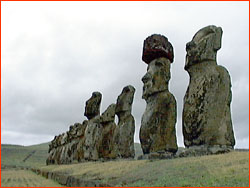
MONSANTO SAVES 70 FOOT-TALL, 400,000-POUND SCULPTURES FROM 5-FOOT WEEDS

Since the early centuries of the Common Era, huge stone statues called moai, up to seventy feet tall and weighing up to two hundred tons, have stood watch over Easter Island, a desolate piece of volcanic rock in the middle of the Pacific Ocean, 1,300 miles away from its nearest neighbor. Relics of a vanished civilization that destroyed its own ecosystem, in part by moving these huge lava bricks across once lush palm forests, for some these statues have become symbols of mindless ecological disaster.
However, as recently as 2000, Monsanto proudly featured "The Moai Sculptures of Rapa Nui" in a company puff-piece, Footprints in the Stone: the Monsanto Stories, which touted the benevolence of donating pesticides for worthy causes.
Though now in a national park, " aggressive non-native weeds, including Johnsongrass brought by early colonists as cattle pasture, threaten the moai with obscurity." [all emphasis added]. This peril came to Monsanto's attention when a Belgian non-profit (DIS) staged a fund-raiser to mount an expedition to Rapa Nui. "Monsanto donated a supply of Roundup herbicide and $10,000 to the expedition. The donation was contigent on [ the vice president of DIS' being able] to obtain permission from the Easter Island Agriculture and Forestry Commission for a weed control program, using Roundup." In 1993 permission was granted since "park officials believed that Roundup's environmental record and its non-staining nature made it the best choice for the moai project." A Monsanto agronomist accompanied the expedition.
Of the first treatment, the president of DIS wrote, "'The weather was fine while we were treating the weeds, but it rained the following day and we were afraid the herbicide was washed off. But when we returned the next week, the weeds were all killed and we were able to begin removing the dead vegetation.'" Now that everyone saw that Roundup was the answer to Easter Island's weed problem., Monsanto's Chilean agronomist trained the local park staff how to spray effectively.
Monsanto's piece on Easter Island concludes: "Like Pompeii, Rapa Nui's moai statues are an important link to the world's past -- a link no longer threatened with burial by encroaching weeds. For centuries to come, the enigmatic moai will continue their silent watch over the loneliest island in the world."
Can we all say stranglehold?